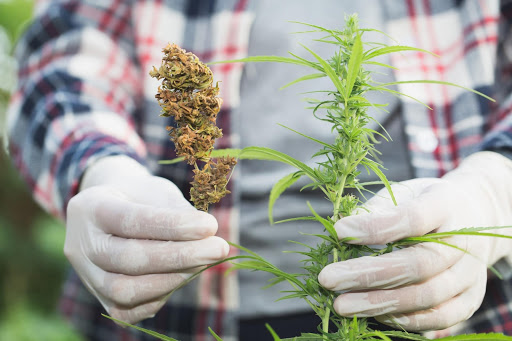Terpenes are that latest craze in the ever-expanding cannabis connoisseur or “cannaisseur” market. In fact, according to one source, the total number of search engine inquiries for the term “terpenes” has increased five-fold in just the past two years. We can only expect this interest in quality marijuana- and hemp-derived products to continue to grow as more and more consumers discover the benefits of higher-end cannabis products, especially those rich in quality terpene extracts. Today, many consumers view terpene content as indicative of the overall quality of a cannabis product’s crop-to-counter harvest and production process. Needless to say, not all terpene extraction methods are created equal. So what are terpenes and how are these compounds best extracted? Let’s take a look…
Cannabis Terpenes — What Are Terpenes?
Nowadays, even casual cannabis consumers are familiar with some of the major cannabis compounds known as cannabinoids. There are more than 100 of these cannabinoids, including tetrahydrocannabinol (commonly referred to as THC and known for the “high” it produces) and the non-psychoactive cannabidiol (or simply CBD). However, fewer individuals are yet privy to the mysterious ways of another set of compounds known as cannabis terpenes. Both cannabinoids and terpenes are secondary metabolites, and researchers have now identified more than 100 cannabis terpenes (although only a handful of these terpenes have been identified in high enough concentrations for laboratory research).
Over time, plants have evolved various terpene profiles for a host of different purposes. Research has shown that some coniferous trees will produce more terpenes to cool the surrounding air and help the plant manage extreme heat. Some plants use terpenes to attract certain animals to facilitate pollination and the dispersal of their seeds. Others have developed defensive terpenes with unpleasant tastes and smells to ward off hungry insects and plant-eating animals. While some of these aromatics are only faintly noticeable to humans, others are quite pungent. For example, when it comes to pine trees, terpenes are responsible for that oh-so-familiar pine scent, and even for the gummy resin along the surface of the plant.
Whether obvious or subtle, these terpenes impart each plant with unique aromatic qualities, adding to their overall bouquets — a crucial component of the cannabis and cannabis-derived products market. Of the known cannabis terpenes, myrcene is the most prevalent. Some of the other most widely studied cannabis terpenes include humulene, pinene, limonene, linalool, and caryophyllene. According to a recent report by Evergreen State College:
“For example, limonene has been a very highly sought after terpene that provides citrus flavors ranging from lemon to orange to pineapple with aromas found almost exclusively in C. sativa strains such as Super Lemon Haze and Tangie.”
As can be readily seen from the lengthy list of scent-related cannabis strains (Blueberry Yum Yum, Banana OG, etc.), these quality cannabis terpenes open up a world of marketing potential, not to mention repeat customers. Beyond the aromatics, researchers are also interested in the purported medical benefits of these cannabis terpenes. For instance, limonene has been linked to “anti-depressant, anti-anxiety, gastric reflux stabilizer, and anti-fungal properties,” according to a recent study. Additionally, another cannabis terpene known as linalool has shown anti-inflammatory effects, and the terpene myrcene has been linked to sedative effects, per some reports. Terpenes may also inhibit or assist the physical and psychological effects of other cannabinoids like THC and CBD.
While the exact underlying mechanisms are not fully understood, these terpenes function as another component of the human endocannabinoid system — an intricate system of receptors, cannabinoids, and metabolic enzymes used to stimulate and regulate our bodies, allowing us to maintain homeostasis.
RELATED: Learn more about the human endocannabinoid system here.
Terpene Extraction Methods — How to Extract Terpenes
Isolating these terpene profiles is becoming an increasingly defining part of the burgeoning high-end cannabis and cannabis-derived products market. That said, not all terpene extraction methods are equally well-suited to the delicate task of removing terpenes from plant material (including cannabis). Compared with other extracts (resins, oils, etc.), cannabis-derived terpenes are delicate and demand extreme care to preserve their sought-after aromatics and flavors. Harsher extraction methods may damage these fragile compounds and diminish overall product quality.
Steam distillation is one of the most popular terpene extraction methods. Unfortunately, steam distillation involves extreme heat, which can alter and even destroy many precious plant compounds, including terpenes. Thankfully, there are other options to choose from that preserve these delicate compounds for a rich, flavorful, aromatic bouquet, namely supercritical CO2 extraction. Supercritical CO2 terpene extraction is a safe, efficient, and environmentally friendly process proven to yield a fresh, clean, aromatic oil, without the quality issues inherent in other terpene extraction methods such as steam distillation.
RELATED: Learn more about supercritical extraction here.
Supercritical terpene extraction also comes without many of the health hazards associated with solvent-based methods. If not properly treated and purged, some chemical solvents (such as butane) may remain in the extracted products, leading to obvious consumer safety concerns. CO2 is tunable, meaning it can be adjusted to isolate a particular compound, such as CBD, THC, or a specific terpene. This fine-tuning involves balancing the temperature and pressure during the terpene extraction process, and the ideal balance varies from plant to plant. Plant materials high in terpenes are best processed at a lower pressure and temperature, while materials high in resin require higher pressures and temperatures for optimal extraction.
To start the process, an internal compressor and heater are used to increase both the pressure and the heat. This allows the CO2 to reach its supercritical state, at which point it has the properties of both a liquid and a gas. In this state, the supercritical CO2 has the ability to pass through the plant material like a gas, while gently dissolving certain compounds like a liquid. In the past, one of the main disadvantages of CO2 terpene extraction was the comparative cost of setup; however, the rise of affordable, modular tabletop CO2 extractors has removed this obstacle.
High Terpene Extract — The Rise of the “Cannaisseur” Market
In previous decades — especially during the peak of the THC arms race — the cannabis industry was focused primarily on THC concentrations. However, the market has become more nuanced and sophisticated as more states have legalized cannabis and cannabis-derived products. This has led to the emergence of a vast spectrum of products, including the higher-end cannaisseur market. As is the case with any industry, a portion of consumers are always willing to pay top dollar for the highest quality products, and the cannabis industry is no different. When catering to the cannaisseur market, it’s important to remember that not all CO2 terpene extraction machines or extraction methods will deliver the same quality products. That said, for those in the market for an affordable, efficient tabletop extraction machine engineered to give operators maximum control and acute precision with every extraction, look no further than OCO Labs Modular Tabletop Extractors.
We update our blog regularly, so stay tuned for the latest on terpene extraction, cannabis-derived terpenes, supercritical CO2 extraction, and much more!






